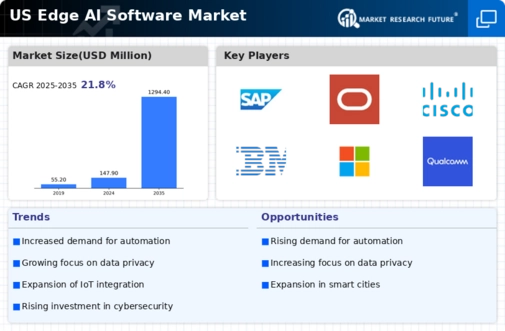The US Edge AI Software Market is a rapidly evolving sector that combines advancements in artificial intelligence with edge computing technologies to enhance processing efficiency and performance at the data source. Competitive insights within this market reveal a dynamic landscape characterized by innovation, strategic partnerships, and acquisition activities aimed at bolstering market presence. In this high-stakes environment, companies are increasingly focusing on optimizing their software offerings to leverage the low-latency and increased data processing capabilities that edge computing provides.
This competitive field encompasses a range of players, each striving to establish a foothold through specialized solutions tailored to various industry needs, including healthcare, manufacturing, smart cities, and IoT applications. The pressing demand for real-time data analytics and proactive decision-making drives continuous developments in edge AI software, thereby fostering a diverse and competitive market ecosystem.SAP has a notable presence in the US Edge AI Software Market, benefiting from its strong legacy in enterprise resource planning and business applications. The company's edge AI solutions excel in integrating advanced analytics and automation capabilities to help organizations utilize real-time data effectively.
SAP's strengths lie in its established customer base, extensive industry knowledge, and a comprehensive suite of software solutions, which facilitates seamless workflows across various business functions. The company leverages its robust cloud platform to enhance data processing capabilities at the edge, offering tailored solutions that optimize operational efficiencies while enabling faster decision-making. Moreover, SAP's commitment to innovation through strategic partnerships further solidifies its standing within the competitive landscape of edge AI software.SAS Institute also plays a significant role within the US Edge AI Software Market, focusing on advanced analytics, machine learning, and AI-driven decision support tools.
The company offers a range of key products and services designed to augment real-time analytics at the edge, making it easier for organizations to harness big data and derive valuable insights instantly. SAS Institute’s strengths lie in its deep expertise in analytics, a strong reputation for high-quality products, and a diverse portfolio that can be tailored to meet the unique needs of various sectors, such as finance, healthcare, and government. The company actively seeks growth opportunities through strategic mergers and acquisitions, enhancing its capabilities and expanding its market share.
Through ongoing developments in its edge AI offerings, SAS Institute aims to empower organizations in the US to achieve real-time insights while improving overall operational performance.






















